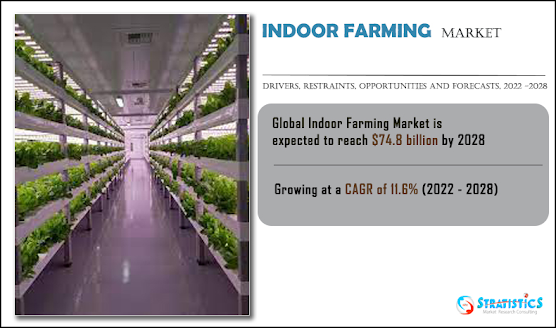Global Indoor Farming Market: Growing Your Future with Sustainable Agriculture
Welcome to the world of indoor farming, where we take agriculture to the next level by providing sustainable and efficient solutions. In recent years, the global indoor farming market has witnessed significant growth, and it is projected to continue to grow at a significant rate in the coming years. With the world population increasing rapidly, and arable land decreasing, indoor farming presents an excellent solution to meet the ever-growing demand for food. In this article, we will explore the various aspects of the indoor farming industry, and how it is shaping the future of agriculture.
 |
| Global Indoor Farming Market |
What is Indoor Farming?
Indoor farming, also known as vertical farming, is a modern agricultural technique that uses indoor facilities to grow crops in a controlled environment. The indoor farming industry relies heavily on technology, such as hydroponics, aeroponics, and aquaponics, to grow crops efficiently without soil. By using indoor farming techniques, farmers can grow crops year-round, regardless of the weather conditions. Moreover, indoor farming consumes significantly less water and land compared to traditional farming methods, making it a sustainable alternative for agriculture.
Market Overview
The global indoor farming market is expected to reach USD 9.66 billion by 2026, growing at a CAGR of 9.2% from 2021 to 2026. The demand for indoor farming is driven by various factors such as the need for a consistent and high-quality food supply, rapid urbanization, and climate change. The market is divided into several segments, including facility type, crop type, and region. The most popular facility types are greenhouses, vertical farms, and container farms. Meanwhile, the most commonly grown crops are leafy greens, herbs, and microgreens.
Benefits of Indoor Farming
Indoor farming offers various benefits over traditional farming methods. First, it allows farmers to grow crops without the need for arable land, making it possible to produce food in urban areas. This is especially important as the world's population continues to grow, and arable land becomes scarce. Second, indoor farming uses significantly less water and fertilizers than traditional farming methods, making it a sustainable alternative. Third, indoor farming allows for precise control of environmental factors such as light, temperature, and humidity, resulting in higher yields and consistent crop quality.
Challenges in the Indoor Farming Industry
While indoor farming offers numerous benefits, it also presents several challenges. One of the most significant challenges is the high initial investment cost. Indoor farming requires significant investment in infrastructure, technology, and equipment. Moreover, the operational cost of indoor farming is also high, with energy and labor costs being the most significant expenses. Another challenge is the need for specialized knowledge and skills. Indoor farming requires technical expertise in areas such as hydroponics, lighting, and automation. Lastly, indoor farming also faces regulatory challenges, as there are currently no specific regulations in place for indoor farming.
Future Outlook
The future of indoor farming looks promising, as it presents an innovative and sustainable solution to the challenges facing traditional agriculture. With the world's population expected to reach 9.7 billion by 2050, indoor farming presents an excellent solution to meet the growing demand for food. Moreover, indoor farming techniques are constantly evolving, with new technologies being developed to improve efficiency and reduce costs. As the indoor farming industry continues to grow, we can expect to see more investment in research and development, leading to further innovations and improvements.
Conclusion
In conclusion, the global indoor farming market presents a sustainable and efficient solution to the challenges facing traditional agriculture. By using advanced technology and techniques, farmers can grow crops year-round, regardless of the weather conditions.


Comments
Post a Comment